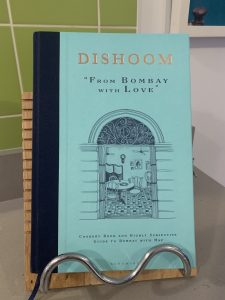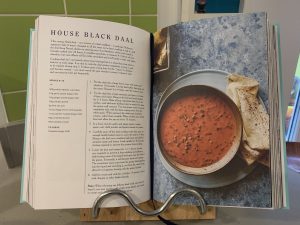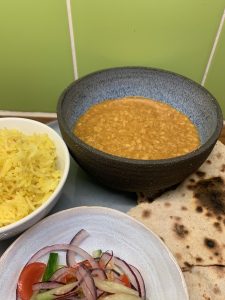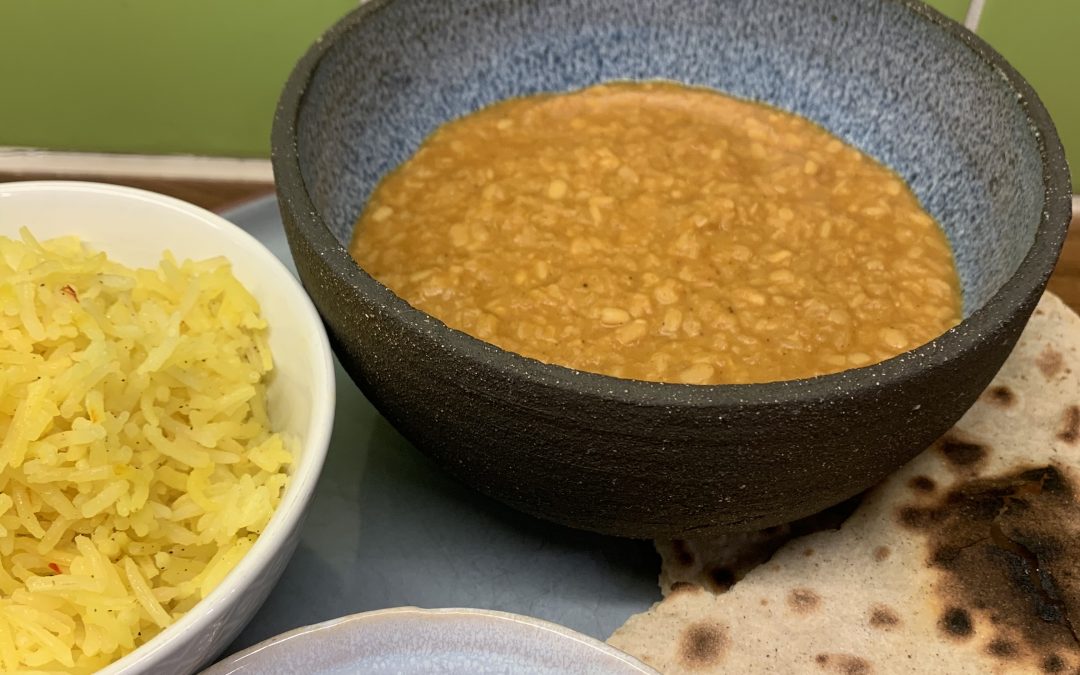This is a recipe for a winter afternoon when you have time at home to watch over the dhal. It’s not a complicated recipe and doesn’t call for too many ingredients.

My Christmas read this year.
It’s based on a recipe from Dishoom: “From Bombay with Love”.

House Black Daal
If you have tasted this dish in the restaurant you will recall it’s so rich and comforting. This version is a little lighter. I used split urad dhal as I didn’t have the whole (black) urad dhal and didn’t add double cream.
To make around 8 servings of dhal you will need:
Ingredients:
- 300g urad dhal
- 4 cloves or garlic mashed to a paste with a little rapeseed or other vegetable oil and a little salt.
- a thumb size piece of ginger. Peeled grated and mashed with a little oil and salt.
- 70g tomato puree
- 5-8g sea salt
- 1/2 tsp chilli powder – depending on how spicy you like it. This wasn’t too spicy. Just a faint heat.
- 1tsp Garam masala
- 90g Ghee or Unsalted butter. For vegan option add a little more good quality oil.
Rinse the dhal 3-4 times until the water runs clear. The recipe suggests whisking it for 10 seconds then rise the water.
Add dhal and enough cold water to fully cover the dhal by around 5cm. Bring to the boil, skimming off any impurities. Lower the heat and simmer and continue to skim for around 2-3 hours. The grains should be completely soft.
Meanwhile, add garlic and ginger puree, tomato puree salt and spices to a bowl and mix to a paste.
When dhal is soft, leave to sit in the water for around 15 mins then drain.
Add freshly boiled water. Enough to cover by a 2-3cm. Add the spice paste and butter and bring to the boil and cook at a high temp for around 30 mins. This is where you’ll need to keep an eye on it, so it doesn’t stick to the bottom. Reduce the heat and cook slowly at a low temp for around 90mins. Add a little water if it becomes too thick and sticks to the bottom. Stir frequently. It’s ready when the grains have disintegrated and it becomes a very thick ‘soup-like’ consistency.
Saffron Rice:
Rinse the required amount of saffron rice. Rinse a few times until the water runs clear. Add double the quality of boiling water to rice and cook covered on a medium heat until the water has been absorbed. Lightly toast a good pinch of saffron in a pan and mix with a few tablespoons of boiling water. When the rice is cooked pour over the saffron water, gently mix through and leave to sit for 5 mins before serving.
To Serve:
I served the with a little picked red cabbage left over from Christmas and a salad of red onions cucumber and tomato and squeeze of lime and pinch of salt.
Chapatis:
If you’re feeling extra hungry, who doesn’t love to scoop the dhal for the bowl with a chapati. This makes around 12 chapatis. I reserved half the dough in the fridge in an airtight container.
Mix: 125g plain flour, 375g atta (wholewheat chapati flour) 8g sea salt, 1/4 tsp granulated sugar. Mix throughly and make a well in the middle.
Combine: 1 egg, 150mls milk (don’t add it all at once as you may need a little less) and 1tbs vegetable oil.
Pour the wet ingredients into the well and gently draw in the flour with a knife. Kneed until you have a soft dough, cover and leave for 30mins. Pull off ball of dough weighing around 70g. Roll as thinly as you can.
Heat the largest pan you have over a high heat. Dry fry the chapati for around 1-2 mins on each side. move the chapati around the pan a little so it doesn’t stick. You can use a folded damp, clean cloth to move he chapati.
Serve warm and enjoy.
My next blog will be some ideas for using the leftover chapati dough for breakfast and lunches.

